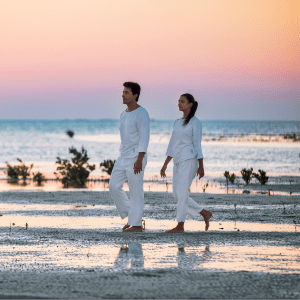 One of the positive aspects of this crisis is certainly the movement of mutual aid and solidarity which currently animates the tourism industry. More than ever, we can and must count on each other to share relevant information, good ideas and best practices. In fact, this response to the crisis reminds us of an acronym that we often repeat to our students: T.E.A.M., “Together Everyone Achieves More“. As a team, we accomplish more, we go further, and we are stronger.
One of the positive aspects of this crisis is certainly the movement of mutual aid and solidarity which currently animates the tourism industry. More than ever, we can and must count on each other to share relevant information, good ideas and best practices. In fact, this response to the crisis reminds us of an acronym that we often repeat to our students: T.E.A.M., “Together Everyone Achieves More“. As a team, we accomplish more, we go further, and we are stronger.
With this same intention of sharing today, we offer six courses of action from which hoteliers can draw inspiration to stimulate demand for a gradual resumption of their activities. Please note: all of these proposals can be implemented in a short period of time, without the need for significant financial resources.
1.Aim for the hyper-local to relaunch occupation in the short term
Pending the opening of borders and therefore of international tourism, the decompartmentalization of regions and the gradual reopening of businesses planned for June 2020 are the two bases on which the operators of accommodation establishments will be able to concentrate their efforts.
As a result, managers will have to develop a plan based on domestic markets and hyper-local clientele: families and friends who will have a strong desire to meet after several weeks of isolation and business trips between and intra-regional could prove to be prime targets for recovery.
For this, create family, meet & greet or reunion packages and think of developing corporate rates for companies whose activities have resumed or will resume in the coming weeks. With all the international business events that have been canceled, it is possible that some companies may wish to meet for a strategic retreat in their community and that they may wish to encourage hotel establishments in their region. Some even suggest privatizing entire premises for establishments that are able to offer this type of option.
It can be strategic for associations to coordinate the recovery with their members to ensure that prices are not pulled down. Positioning the destination and playing as a team, between hoteliers, could prove to be a long-term winner.
2. Stimulate staycations to anchor your positioning
Let’s not underestimate the impact that staycations could have. This invitation to take a vacation close to home gained popularity during the economic crisis of 2008: “Faced with a tight budget, many families have no choice but to escape the routine without traveling. (…) Although the trend was first born of financial constraints, the reality is now quite different. Today, staycation is often a personal choice, and the phenomenon has followers all over the planet.“. It could therefore be profitable for hoteliers to think of making overnight stays more accessible for residents of their municipality (reduced prices on proof of residence, added value with a “special local” package, etc.).
It is a safe bet that the “confined” may have a desire to get out of the ordinary and have an out-of-home experience, while respecting the new health standards. To do this, put your promotional efforts on those who already know you – in the same city – but who have never thought of staying with you for an overnight stay (or two!). In other words, give them a unique experience, close to home but far from their daily lives!
For example, the Estérel Resort –a well-known resort in Quebec, just an hour from Montréal– has just sent its community a newsletter in which their Christmas promotions are announced … in April! By being proactive and capitalizing on their star packages, this establishment in the Laurentians plays on the emotions of people who will have the desire to experience tourism again.
Create a sense of belonging with the members of your local community: they can become your best ambassadors!
3. Reassure visitors by moving from story-telling to story-caring
You know as much as we do: the goal of a hotelier is not only to ensure satisfaction but to aim for loyalty. For this, the narrative used, the selected images and the stories that are told are often the triumvirate of the marketing strategy put forward to stimulate demand. The example of MGM Resorts and their campaign “The Holy S *** Business” often comes up as a very powerful story, motivating and which explains, in a few words, the vision of the company. Ditto for the last original Quebec campaign, #pouruninstant (“for just a moment” in french), which is adapted to the current context while powerfully focusing on emotions.
In times of compulsory “sani-management“, hoteliers should build their story-telling with this mantra in mind which we often share with our students “Security is the new marketing”. In other words, moving from a story-telling to a story-caring, the hotelier tells a reassuring story that is based on “taking care”, on the feeling of care for visitors. It is no coincidence that the English term hospitality is so close to hospital, hospitable. The concept of “care” is the common denominator of these two areas which come together at the root of their raison d’être.
Concretely, it is suggested to take advantage of social networks to bring the new customer journey to life by showing the measures implemented to comply with health standards. If you take the temperature of each customer at the entrance with an infrared thermometer and you have installed hand cleaning stations, well, announce it! If you have limited the number of people in the elevators and there is only room service, turn this to your advantage by focusing on your understanding of the issues while providing personalized service! If customers are still hesitant to book, seeing the changes and new practices in practice could encourage them to click on the famous button.
Communicate a story that inspires confidence so that visitors will want to come to your place. They will feel safe, in a cocoon, like at home. It is the famous “Home away from home” popularized by Four Seasons which can be the basis of this strategy.
4. Make sanitation sexy
What hoteliers will put in place in the short term will not be in vain: we know that social distancing will be omnipresent for several more months. Therefore, the biggest challenge for hoteliers will be to make sanitary facilities sexy. To do this, consider diversifying and personalizing your hospitality products with personal protective equipment. Whether it’s offering a good quality washable mask with the image of the hotel (imagine customers walking around town with the colors of your establishment, much like the umbrella does!), Bottles of disinfectant with your logo and why not, gloves, all options are on the table. Suppliers are waiting for your call to personalize these products. Once you have them, get your community involved by posting it all on social media.
In a webinar broadcast on April 25, with the theme A Timeless Service Philosophy for Uncertain Times, Jeff Wielgopolan, Vice President of Learning and Development at Forbes Travel Guide, defined luxury in these terms: “Luxury is the ability to not have to think.“. This means that luxury is not only reserved for 5-star establishments: it is possible and even necessary to offer comforting and humane experiences in all types of accommodation. Making sanitary facilities sexy, attractive, harmless and, at the very least, cute, is one of the elements that will cause customers to want to book with you.
Readjust your complementary offer by adapting your hospitality products to the new reality of “2-meter tourism”. You will launch the message that you have adjusted and that you want to simplify the customer’s stay by providing everything they need to be safe.
5. From behind the scenes to front of the house
In order to provide as much information as possible to reassure your customers, install the material safety data sheets for the products you use to disinfect the raw materials (food served to customers, free bottles of water, etc.), equipment (menus, luggage carts, etc.), rental spaces (bedrooms, conference rooms, shops, etc.) and public areas (toilets, parking, lobby, terrace, etc.). Some even go so far as to detail the cleaning steps and training that their employees have taken. Admittedly, this would have been unthinkable two months ago, but the new normality requires complete transparency on the ways of working.
Customers will have expectations: both anticipate them and detail the practices. You will be seen as an establishment that considers health management fundamental while providing a hotel experience based on respect and empathy.
Create a link with your community by being transparent about your practices. This could stimulate demand and translate into higher bookings. The magic thought – that everything will resume normally, effortlessly – is not recommended.
6. Go back to your DNA and what you do best
The Hong Kong Intercontinental recently posted this suggestive thought on social media: “While hearts have not changed, the world has changed.“. That is true! Let’s remember that as hoteliers, we are the bearers of memories, emotions and desires. We promise – and deliver! – memorable experiences. Let’s not lose our reason for being: the pleasure of making people happy.
It is therefore essential to return to your DNA, to what defines you best. Take the time to think about it: why did you choose the hotel and hospitality industry? What makes your hotel unique to your customers? In your eyes? To those of your employees? Have you ever tried to define your business in three unique words? Three words that apply perfectly to your mission, your positioning, the trace that you want to leave in the minds of your customers? Knowing yourself well is always the first step to selling yourself to the world and creating a strong brand image. Do the exercise by involving your work teams: it will never be a waste of time.
Identify your competitive advantages: be it the breathtaking view of the river, your unique geographic location, the skill of your team in place, your new renovations or the packages you offer. This will make you authentic and therefore attractive to potential customers. Build on your strengths and return to your “why” as Simon Sinek, author of the bestseller “Start with why” says.
While Skift has just published 100 forward-looking questions about the future of tourism (see numbers 40 to 53 for accommodation), hoteliers have two priorities for coping with uncertainty: adapting their service design to new health standards and by doing everything to stimulate demand. These are the two pillars on which the future of our field rests and on which they can act proactively.
To conclude, let us quote journalist Françoise Giroud: “The borders of the world stop at the people we love.“. By being creative and putting into practice the six reflections that have been presented in this text, let us ensure that the borders of the world also extend to those of hoteliers because, it is all together that we will get there.
* This article was first published in French for ITHQ.


















